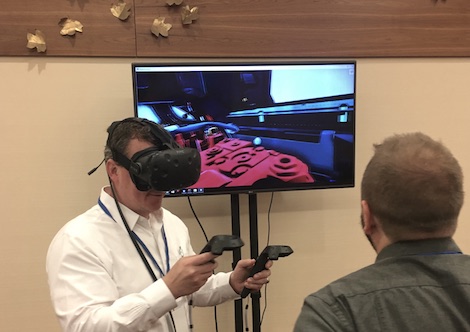
Siemens PLM is developing a workflow for incorporating CAD into VR
There’s a huge amount of buzz around virtual reality (VR) at the moment: The rise of lower cost headsets that allow you to track not only head movement, but also movement around a specific area, has meant that many are predicting a rise in the use of such technology in the design and engineering space.
Yet one thing is currently missing – a workflow. VR requires that you’re running at high frame rates (90fps), otherwise you’re going to end up reaching for the nearest available wastebin to help with the motion sickness you’ll end up getting.
That means that to use these tools for any length of time, you need powerful graphics hardware and a software solution that can handle CAD geometry in a manner that suits.
Current solutions typically require that CAD geometry is tessellated and de-polyed to help with that grunt – and they’re typically running through a game-focussed engine (such as Unity or Unreal). At present, there’s no slick way to take your CAD geometry and prep it for VR without spending weeks working on the model.
Last week at Solid Edge University in Indianapolis, Siemens showed off a demo of a system that’s currently in the works called Dolphin.
This is a collaborative effort between Siemens and a UK VR specialists, Masters of Pie.
Details are scant and some still unconfirmed, but what we can tell you is that it’s a mix of some clever work from the development to take data from your CAD system and load it up into a VR environment in which you can explore your product.
The clever part is that the whole process is based on Siemens’ JT format.
Those with experience working with JT will know that the system already is capable of containing various levels of detail of a tessellated geometry of a product model. It retains the product structure, motion and much more. What the team working on Dolphin look to be doing is finding a way to quick import that intelligent geometry and prep it for VR.
We had a little play with the system on show and it’s impressive. The visual quality is solid, the ability to walk around a product, inspect, evaluate and measure it is excellent. There’s a formative bunch of control to help with moving around the model, of controlling scale (there’s an Ant Mode that can get you inside the product and allow you access to visualization that wouldn’t typically be the case).
There’s also talk of a VR telepresence capability, so you can connect sessions (irrespective of geographic location) together and not only working the same data model, but to be able to see where the other person is.
There’s all manner of goodies – and given that it’s built on top of Unity, the system should be pretty hardware agnostic and the ability to plug in newer hardware as it comes on-line shouldn’t be too much of an issue.
There’s not much more to tell you for now (not even google can find a reference to it), the system is still being worked on and a go-to-market plan is yet to be confirmed, but this thing looks good, assuming that Siemens package it correctly.
After all, there’s one thing to have a 500 quid VR headset, it’s another thing if the software you need to drive it costs upwards of £15k.
VR for design and engineering will take off in 2017 (I’d bet my salary on it), but what’s missing is an efficient solution for taking your CAD data and getting it into the environment efficiently – and it looks like Siemens have something up their sleeve.
With the launch of other systems in the near future (such as Virtalis’ VR4CAD), it’s all looking interesting.






